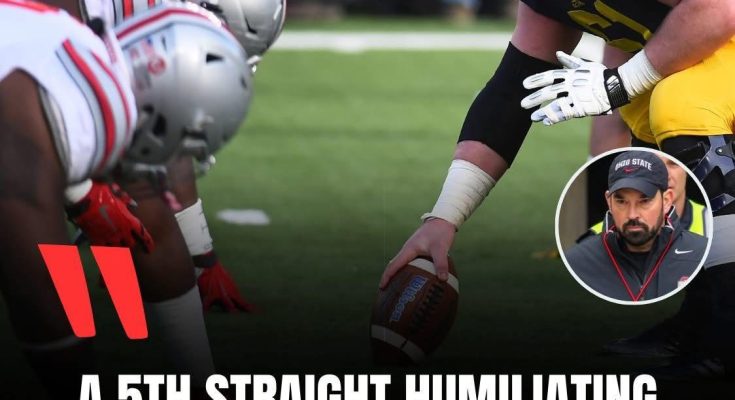It was a moment that seemed to shake the very foundations of Columbus and spark a broader debate across college football. Ohio State, heavily favored, succumbed 13–10 to archrival Michigan, marking the program’s fourth straight loss to the Wolverines. This painful defeat—embedded in context, consequence, and culture—set off a wave of backlash against head coach Ryan Day, even as he retained firm backing from the university’s leadership. The narrative unfold in layers: tactical missteps, passionate fans demanding accountability, Day’s emotional ownership, and contrasting institutional allegiance.
The game’s echoes lingered long after the stadium emptied. Fans erupted in fury on social media, with the hashtag “Fire Ryan Day” trending. One voice on social media succinctly expressed a sentiment widely shared: “Most embarrassed I’ve ever been as a fan of a sports team. Fire Ryan Day immediately.” Another lamented, “This is the worst moment of my life. You gotta fire Ryan Day.” Protestations intensified as alumni, boosters, and officials grappled with the weight of four straight failures against Michigan—something not seen since the late ’80s, during the John Cooper era .
The backlash wasn’t limited to anonymous posts—it echoed through school halls and corridors of power. In the aftermath of the defeat, Ohio State Athletic Director Ross Bjork moved swiftly to quell mounting speculation about Day’s future. Speaking to The Columbus Dispatch, Bjork affirmed, “Our full focus right now is on the College Football Playoff and making a strong run. … Coach Day does a great job leading our program. He’s our coach.” Despite the fan fury, Bjork emphasized program stability, the strength of recruiting, and donor confidence as under Day’s leadership, stressing “Our program is built to last” .
Still, supporters and critics alike evaluated the defeat through different prisms. For some, annual wins over Michigan were non-negotiable. For others, Day’s overall record—66-10, with sustained Big Ten dominance—offered forgiveness if the Buckeyes made a deep playoff run . But nothing overshadowed the optics of losing four consecutive games to the rival; the last streak of equal length was from 1988–1991 .
Ryan Day himself did not shy away from accountability. Within days, he addressed the media in a signing-day press conference with stirring candor: “There’s no way to defend losing four years in a row… I was in shock after the game, I really was.” He acknowledged multiple failures—offensive predictability, poor pass protection, red-zone inefficiency, missed field goals by Jayden Fielding, and special teams breakdowns . Reviewing the tape, Day singled out the offensive gameplan, admitting, “Without question they ran the ball too much on the inside… There’s no question we could have done a better job getting the ball to the perimeter.” He took full responsibility, stating, “Ultimately, that comes back on me as the head coach” .
Not all Ohio State fans were unmoved by his admissions. Yet, some softened once Day spoke honestly. As one Reddit user reflected:
“The thing that frustrated me the most about the Michigan game was the stubbornness of the gameplan… What was worse was Ryan initially wasn’t willing to own the mistake immediately after the game… By Tuesday in a press conference he said exactly that. He was forgiven and I had his back.”
That admission reflected a broader theme: leadership under pressure matters.
Still, not everyone was satisfied. On game day, scenes turned ugly. Michigan players, exultant, attempted to plant their flag at midfield—provoking Ohio State defenders to retaliate. A melee ensued. Edge rusher Jack Sawyer ripped the flag loose, and police swarmed, resorting to pepper spray to break up the chaos. The Big Ten ultimately fined both schools $100,000 each . That moment symbolized the emotional volatility of “The Game,” and for Day, who stood nearly motionless amidst the eruption, it underscored how deeply the rivalry has wounded him. As one report captured, chanting fans yelled at him: “Hope you have your next job lined up” and “This is your last day” .
For the alumni, boosters, and administration, the playoff offered redemption. Day’s task: turn anger into fuel. There was history of comeback. Earlier in the season, after the Michigan loss, Day’s team regrouped and manufactured a run to the National Championship game. That journey was fueled by honest reckoning and unity; defensive end Jack Sawyer later praised the team’s decision to “rally instead of succumb to defeat” .
Shannon Sharpe, though unsparing, framed the reality of Day’s situation: “I ain’t going to lie, I don’t know how Ryan Day keeps this job, I don’t.” But even after the national title, Sharpe refused to retract his criticism, not because Day had failed, but because with Ohio State’s resources and talent, championship wins are expected, not excused .
Still, for many Ohio State insiders, even the most vocal critics, playoff success changes the narrative. As one AP writer noted, Day was in chaos after the Michigan loss but remained the head coach heading into the postseason. “What may be saving Day’s job immediately is that Ohio State is No. 6 in the latest College Football Playoff rankings… If the Buckeyes win a national championship, all will be forgiven.” .
Institutional support from AD Ross Bjork remained consistent. Nearly a month after the loss, Bjork reiterated: Ryan Day would return in 2025. He emphasized focusing on development rather than instant judgment, leaning on Day’s exceptional record and leadership stability .
The broader lessons of this clash go beyond just wins and losses. Big ten media rights deals have injected massive revenue and elevated stakes of every game—from rivalry matchups to title pursuits. Within that hyper-competitive climate, annual dominance over Michigan defines legacies. Yet the new 12-team playoff structure reframes the season: a single loss no longer erases championship opportunities . For Day, that format offered opportunity: a chance to erase the defeat with greater success.
But the backlash also revealed something deeper: the identity of Ohio State fans hinges on beating Michigan. The pain of losing “The Game” wears on collective memory, making any coach vulnerable if that streak crosses four consecutive years. The calls to fire Day were emotional—but also cultural.
Day’s response, though imperfect, demonstrated leadership under fire. He accepted blame, showed emotion, faced criticism, and oriented toward redemption. That humility and resolve resonates with some beyond rose-tinted fans. But in Columbus, only one measure matters: continued success, especially when the unforgiving Wolverines are involved.
This friction between personal and institutional trust, between emotion and strategy, honors the rich tapestry of college football. One loss doesn’t define dynasty—but repeated defeats to your biggest rival can destabilize even the most successful coach. The question now is whether playoff glory can repair wounds in time.
As the program moves forward, its trajectory depends not just on X’s and O’s, but on how Day rebuilds trust—with fans, players, and donors—and how realignment between expectations and execution is executed. In short: Redemption isn’t guaranteed—but for Ryan Day, the stakes have never been higher.



